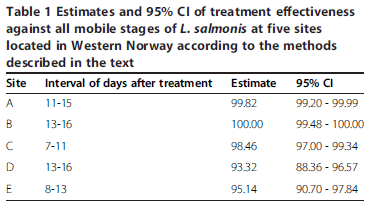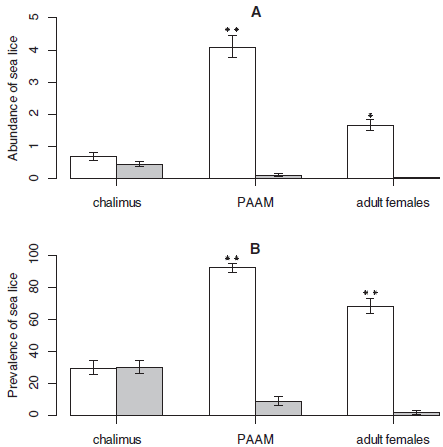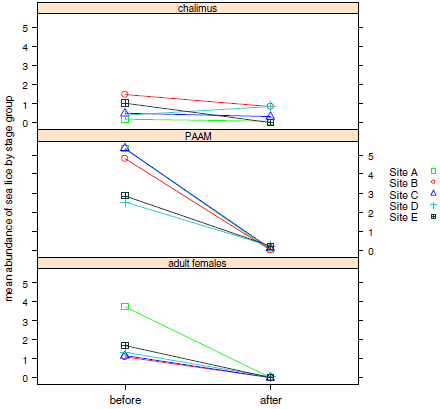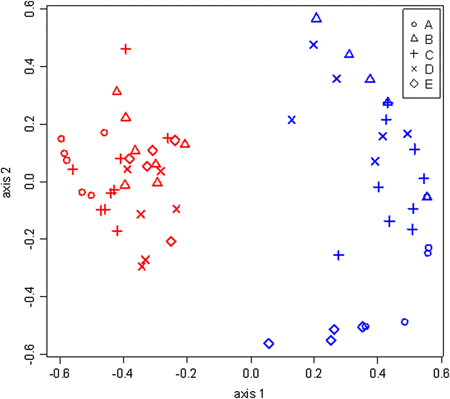The Norwegian Food and Safety Authority (NSFA) have implemented precautionary measures to reduce the impact of sea lice from salmon production sites. These measures mandate the delousing or harvesting of production sites once sea lice infestations surpass the threshold set by NSFA. While novel intervention strategies are being explored, the successful control of sea lice infestations in production sites is currently heavily dependent on effective delousing using chemotherapeutants.
Management systems for production of salmon in Norway have rapidly grown in the last decade, largely through intensification of fish production through the use of large pens and automation of feeding. Such operations however may magnify certain problems associated with the application of bath treatments. For example, the effectiveness of topical bath administrations is dependent on accurate dosage and a rapid and uniform distribution of the chemotherapeutant in the water column. Inadequate medicinal exposure will result in incomplete treatment. The unintended effects of inadequate treatments include the repeated usage of chemotherapeutants over the production cycle and a risk that chemical resistance will emerge in sea lice populations.
Evaluation of field treatment effectiveness should identify those treatments that do not achieve the expected effect. Whilst reported treatment failures have been identified in Norway using alternative methods such as bioassays and probit modelling, current methods monitor the average reduction in mobiles (pre-adult and adult sea lice) following treatment. This simplified analysis risks overlooking changes that may cause treatment failure such as reduced sensitivity to chemotherapeutants.
Multivariate analyses enable the concurrent evaluation of effectiveness of treatment against all sea lice life cycle stages. Delousing effectiveness is multifactorial, being dependent on the interaction between biotic factors, such as life cycle stage, gender and phase in the molting cycle, as well as abiotic factors such as water temperatures and salinity. Consequently, a more robust interpretation of treatment effect can be made by incorporating data from sea lice life cycle stages. This type of approach is used in ecological studies to evaluate the effect or alterations that environmental stressors or toxicants produce in the composition of species community.
Our aim was to develop improved methods for the evaluation of treatment effectiveness in the field. Evaluation of treatment effectiveness against stages of salmon lice using multivariate methods provides a complete assessment of the overall effect of the drug and allows detailed comparisons between treatments. Specifically, it reveals those life cycle stages of L. salmonis that after treatment were characteristic of particular sites and hence which had potential use as indicators of treatment failure. Multivariate analysis also reveals other aspects that can be of interest when evaluating drug effects such as the changes in composition of L. salmonis stage groups following treatment.
Results
Presence and abundance of sea lice by stage group
Treatment with cypermethrin resulted in reducing mean abundance of pre-adult and adult male stages (PAAM) as well as adult female stages of L. salmonis at all five sites (Table 1, Figure 1) which, according to univariate analysis indicates an effectiveness in excess of 90 per cent for all sites.


The variation in mean abundance of the three stages between sites, shown in Figure 2, found the effect of treatment against PAAM and adult females was similar and consistent between sites but that the reduction in chalimus stages was modest with an average reduction in abundance of 49 per cent (95 per cent CI: 20–80). This value varied between sites, with one site indicating an increase in chalimus abundance following treatment. The reduction in chalimus was only significant at site E (100 per cent), with sites B and C having less than 50 per cent reduction. Tukey’s HSD test found that chalimus were significantly higher posttreatment (p-value <0.05) at sites B and D compared to A and E, and that site B was significantly higher than site C. Post-treatment pairwise site comparisons for PAAM and adult female stages indicated no significant differences.

Changes in the composition of sea lice stages with treatment
The changes in stage group composition from pre- to post- treatment were analysed using multivariate analyses. The effectiveness was assessed through the use of an ordination plot (stress = 1.3) (Figure 3) which provides a diagrammatic representation of the composition of stage groups at each site. The overlap of both pens and sites is shown in the clustering of pens before treatment (red symbols), whereas the dispersion of results across pens after treatment (shown in blue), indicated increased heterogeneity among pens and among sites. The within-site heterogeneity of stage groups both before and after treatment with cypermethrin is summarized in Table 2.


Differences between sites both pre- and post- treatment, shown in Figure 2, were analysed by non-parametric permutational multivariate analyses (Table 3) to determine the extent to which production sites had similar composition of sea lice stages. Three procedures indicated statistically significant differences between sites in the composition of sea lice before (p-value <0.01) and after treatment (p-value <0.01).
Results of the test statistics for MRPP (A statistic), ANOSIM (R statistic) and Adonis (R2 value) indicated that differences between sites became larger posttreatment (A = 0.359, R = 0.576, R2 = 0.627) than before treatment (A = 0.246, R = 0.353, R2 = 0.459) (Table 3). To identify which stage groups were responsible for the observed changes in composition between sites (p-value < 0.1, see Methods), we quantified the various life cycle stages (chalimus, PAAM and adult females) before and after treatment (Table 4). Prior to treatment, chalimus and adult females accounted for the differences in composition between sites; whereas after treatment the chalimus (p-value = 0.013) and PAAM (p-value = 0.066) stages were responsible. Following treatment, relative frequency and abundance of PAAM were higher at sites D and E; while for chalimus these were higher at sites B and D compared to all other sites. Counts of adult females were consistently low after treatment and had no significant indicator species value.
At one site (site D) cypermethrin treatment was less effective against all stage groups. Analysis at pen level for site D showed that treatment against PAAM and adult females was effective for all pens (above 90 per cent) except for one where the percentage reduction for PAAM was 63 per cent (95 per cent CI: 10–87) and for adult females was 82 per cent (95 per cent CI: 50– 96).
Discussion
Synthetic pyrethroids are widely used against sea lice in Norwegian aquaculture. Three synthetic pyrethroids are available for lice treatments, cypermethrin (Excis®) deltamethrin (Alpha Max®) and high-cis cypermethrin (Betamax®). These compounds have similar characteristics (administration and distribution), mechanisms of action, and therapeutic efficacies. Synthetic pyrethroids are insecticides that act by preventing closure of voltage-gated sodium channels resulting in abnormal hyper excitability, spastic paralysis and death. Synthetic pyrethroids are highly efficacious against PAAM and adult females but reportedly less efficacious against chalimus stages.
Current analytical methods for evaluating treatment effectiveness calculate the percentage reduction in the mobile stages only. This method has low sensitivity when sampling is limited and is unlikely to fully reflect the treatment outcome since calculation of treatment effectiveness is based on average abundance for only one stage group (PAAM or all mobiles). It is recognised that univariate analyses fail to control for experimental error and do not take account of the covariance structure in the data. We performed multivariate analyses to combine the information from all group stages and determine the stage groups that best indicate (changes in magnitude or direction of ) treatment effectiveness. This assessment of the community structure differs from the more statistical approaches to clustering adopted in previously published research.
In this study, we examined the effectiveness of cypermethrin treatments conducted in 33 pens at five different sites. Treatment with cypermethrin resulted in a larger than 90 per cent reduction of all mobiles, which would conventionally be taken as an indication that treatment was effective at all sites. However, high treatment effectiveness against chalimus was observed only at one site, which suggests that chalimus was the only stage group that contributed to the significant differences in abundance observed between sites after treatment. Absolute numbers of chalimus were low which makes it difficult to evaluate treatment effectiveness. In addition these smaller stages are more difficult to enumerate accurately when sampling live fish in a production environment.
We had expected effective treatment to homogenize the initially heterogeneous sea lice populations, yet multivariate analysis and ordination analysis revealed that there existed a latent representation of sea lice stage composition that indicated increased heterogeneity following treatment. In particular chalimus and to a lesser extent PAAM were identified as stage groups accounting for the phenomenon observed.
Several site factors could offer explanations as to how differences in estimated treatment effectiveness arise. One factor may be water temperature. Low water temperatures can significantly delay the development of chalimus stages. This is suggested by the limited reduction of chalimus in low temperatures at sites B and C, despite the significant reduction in PAAM. It has been shown that time to chalimus mortality following application of cypermethrin is increased with low temperatures. The reduction in chalimus observed at site C was 37 per cent (mean abundance was 0.31 [95 per cent CI: 0.21-0.39]) 10 days after treatment; however, 20 days after treatment this reduction had increased to 90 per cent (mean abundance at site C was 0.02 [95 per cent CI: 0.00-0.06], while no increase in PAAM was observed), consistent with a delayed molting due to low temperature.
A further contributory factor may be the effect of cypermethrin on the development of the chalimus since cypermethrin delays metamorphosis within the chalimus stages. The combination of temperature and developmental delay in chalimus will differentially affect the stage group composition and argues for the analysis of all stage groups when determining treatment effectiveness for this type of topical intervention. Since univariate analysis utilizes only changes in PAAM or mobile populations the assessment of treatment effectiveness will be incomplete and potentially misleading.
The time interval between treatment and sampling was not identical across sites. The size of treatment effect will be influenced by the time interval between treatment and sampling. It may therefore be advisable to standardize the time at which treatment effectiveness is observed.
Using univariate methods, cypermethrin treatment was highly effective against PAAM stages, as defined by a reduction in the lice numbers equal or larger than 90 per cent. Multivariate analyses questions this apparently satisfactory outcome. Effectiveness following treatment may not be as simple as a numerical reduction in a particular lice stage but may for example be a change in the distribution of population numbers across several lice cycle stages following treatment, an alteration of the sex ratio of the adults or an unforeseen delay in stage development. Multivariate methods yield data that may help more accurately define treatment effectiveness and we recommend the adoption of such methods in order to study empirical data from ‘best practice’ treatment studies.
Overall, cypermethrin treatment was effective at all production sites but differences were found in the composition of sea lice stages between sites after treatment. As treatment effectively reduced the PAAM and adult females this suggests that abiotic factors may account for differences in sea lice composition after treatment between sites. This aspect cannot be addressed from our data due to a limited sample size of five farms. Identification of these factors merits further investigation.
Conclusions
The efficacy of outcome from topical treatment with synthetic pyrethroid is multifactorial, and not solely dependent on achieving adequate levels in the water column. With the emergence of chemical resistance there is a pressing need for comprehensive interpretation of collected data such as that offered by the multivariate approach. We have used multivariate methods to evaluate the effectiveness of cypermethrin treatment against sea lice. Multivariate methods, unlike the currently adopted univariate methods which focus on a single stage group of L. salmonis, provide an improved measure of the treatment effectiveness against all parasitic stage groups. Multivariate analyses could be extended to evaluate treatment against other ectoparasites of veterinary and medical importance.
January 2014



